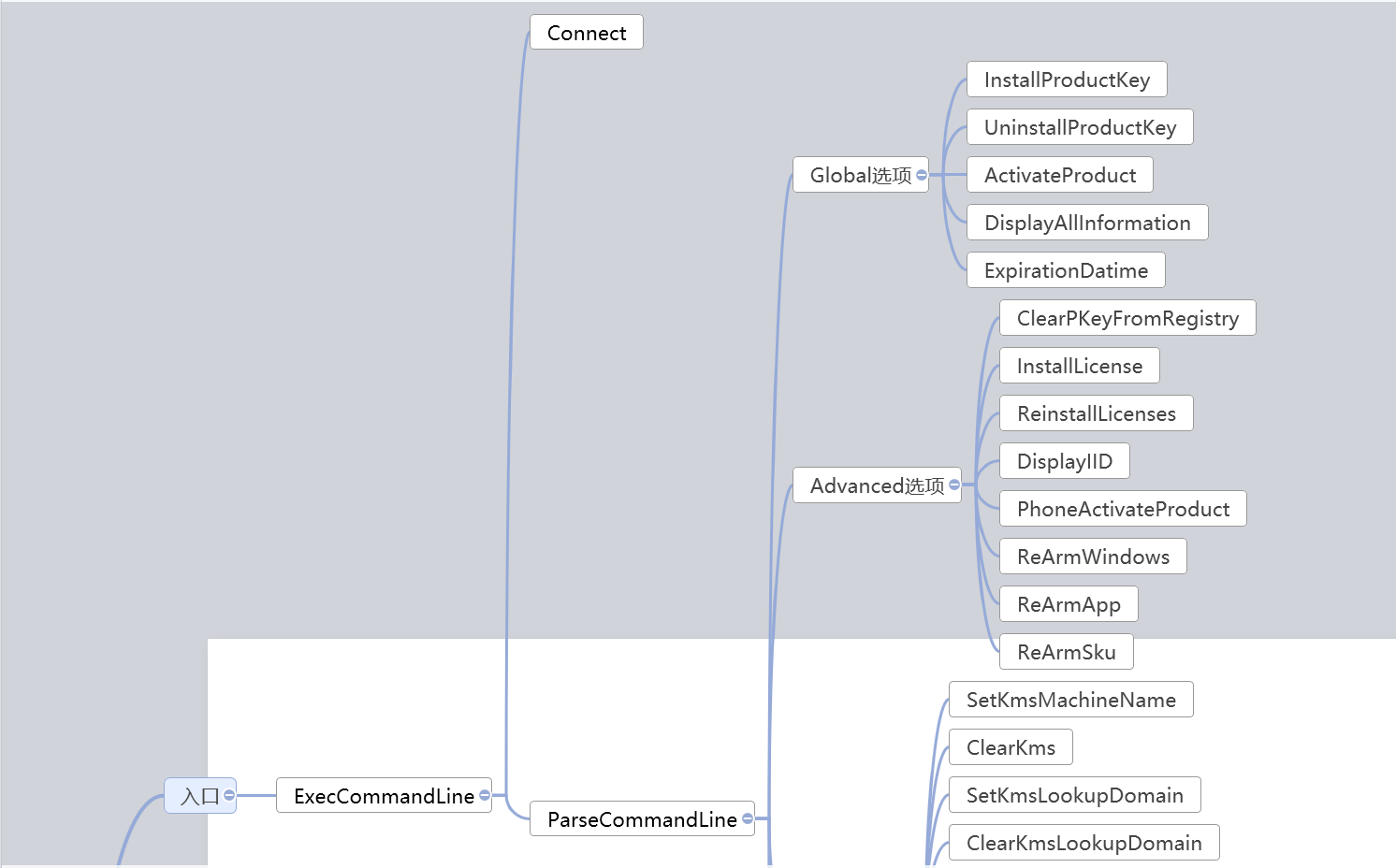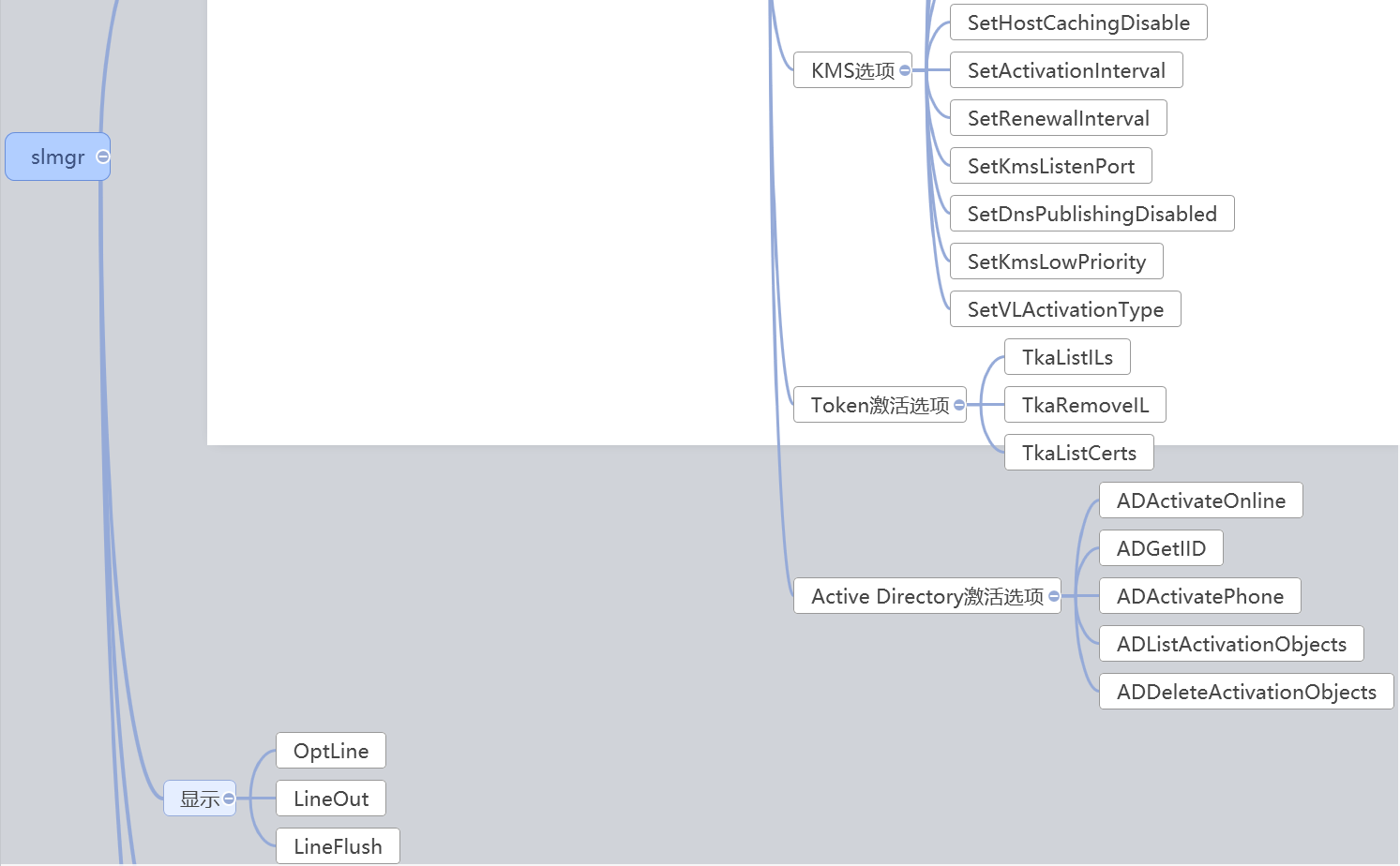之前大佬要我做一款windows一键激活工具。基本原理是利用我们的license,从后台请求一个微软的正版license,然后调用slmgr进行windows激活。这样就可以把license的控制权留在自己这里,而不用传递给工厂,避免license流失。(所以期望从本文找破解方案的同学可以散了233)所以记录下对slmgr的研究。
slmgr是一个vba脚本,整体的结构如下图所示。可以看到整个结构基本都是面向功能的,十分容易理解。
其主要功能就是通过指定的命令进入分支语句,然后调各个功能模块方法



我们先来看看主要的入口函数ExecCommandLine。归结起来就2句话,1是执行Connect,获取WMI服务和注册表;2是根据命令参数执行不同子模块功能
Private Sub ExecCommandLine
Dim intOption, indexOption
Dim strOption, chOpt
Dim remoteInfo(3)
'省略中间的参数检测代码
'连接至本地计算机或者远端计算机,以获取WMI服务和注册表
Call Connect()
If intUnknownOption = intOption Then
LineOut GetResource("L_MsgInvalidOptions")
LineOut ""
Call DisplayUsage()
End If
'针对不同的命令参数执行子函数
intOption = ParseCommandLine(indexOption)
If intUnknownOption = intOption Then
LineOut GetResource("L_MsgUnrecognizedOption") & WScript.Arguments.Item(indexOption)
LineOut ""
Call DisplayUsage()
End If
End Sub
Connect的源码如下,其主要功能是从参数中判断是否是对本地计算机处理,针对远端计算机和本地计算机,采用不同方式获取WMI服务和注册表
Private Sub Connect
Dim objLocator, strOutput
Dim objServer, objService
Dim strErr, strVersion
On Error Resume Next
'如果是本地计算机,则直接获取WMI服务和注册表
If g_strComputer = "." Then
Set g_objWMIService = GetObject("winmgmts:\\" & g_strComputer & "\root\cimv2")
QuitIfError2("L_MsgErrorLocalWMI")
Set g_objRegistry = GetObject("winmgmts:\\" & g_strComputer & "\root\default:StdRegProv")
QuitIfError2("L_MsgErrorLocalRegistry")
Exit Sub
End If
'否则建立远端连接
' Create Locator object to connect to remote CIM object manager
Set objLocator = CreateObject("WbemScripting.SWbemLocator")
QuitIfError2("L_MsgErrorWMI")
' 获取远端WMI服务
Set g_objWMIService = objLocator.ConnectServer (g_strComputer, "\root\cimv2", g_strUserName, g_strPassword)
QuitIfError2("L_MsgErrorConnection")
g_IsRemoteComputer = True
g_objWMIService.Security_.impersonationlevel = wbemImpersonationLevelImpersonate
QuitIfError2("L_MsgErrorImpersonation")
g_objWMIService.Security_.AuthenticationLevel = wbemAuthenticationLevelPktPrivacy
QuitIfError2("L_MsgErrorAuthenticationLevel")
' Get the SPP service version on the remote machine
set objService = GetServiceObject("Version")
strVersion = objService.Version
' The Windows 8 version of SLMgr.vbs does not support remote connections to Vista/WS08 and Windows 7/WS08R2 machines
if (Not IsNull(strVersion)) Then
strVersion = Left(strVersion, 3)
If (strVersion = "6.0") Or (strVersion = "6.1") Then
LineOut GetResource("L_MsgRemoteWmiVersionMismatch")
ExitScript 1
End If
End If
Set objServer = objLocator.ConnectServer(g_strComputer, "\root\default:StdRegProv", g_strUserName, g_strPassword)
QuitIfError2("L_MsgErrorConnectionRegistry")
objServer.Security_.ImpersonationLevel = 3
Set g_objRegistry = objServer.Get("StdRegProv")
'获取注册表对象
QuitIfError2("L_MsgErrorConnectionRegistry")
End Sub
接下来是ParseCommandLine函数,其就是简单的一个switchcase,根据输入的命令参数不同,执行不同的激活命令。
Private Function ParseCommandLine(index)
Dim strOption, chOpt
ParseCommandLine = intKnownOption
strOption = LCase(WScript.Arguments.Item(index))
chOpt = Left(strOption, 1)
If (chOpt <> "-") And (chOpt <> "/") Then
ParseCommandLine = intUnknownOption
Exit Function
End If
strOption = Right(strOption, Len(strOption) - 1)
If strOption = GetResource("L_optInstallLicense") Then
If HandleOptionParam(index+1, True, GetResource("L_optInstallLicense"), GetResource("L_ParamsLicenseFile")) Then
InstallLicense WScript.Arguments.Item(index+1)
End If
ElseIf strOption = GetResource("L_optInstallProductKey") Then
If HandleOptionParam(index+1, True, GetResource("L_optInstallProductKey"), GetResource("L_ParamsProductKey")) Then
InstallProductKey WScript.Arguments.Item(index+1)
End If
ElseIf strOption = GetResource("L_optUninstallProductKey") Then
If HandleOptionParam(index+1, False, GetResource("L_optUninstallProductKey"), GetResource("L_ParamsActivationIDOptional")) Then
UninstallProductKey WScript.Arguments.Item(index+1)
Else
UninstallProductKey ""
End If
'中间还有一堆else if省略
Else
ParseCommandLine = intUnknownOption
End If
End Function
我们选取其中最重要的一个函数ActivateProduct来分析下。源码有部分删减,其中过程是获得一个叫“Version”的服务对象,从所有产品列表中检查是否是指定的产品,进行激活并更新状态。
Private Sub ActivateProduct(strActivationID)
Dim objService, objProduct
Dim iIsPrimaryWindowsSku, bFoundAtLeastOneKey
Dim strOutput
Dim bCheckProductForCommand
strActivationID = LCase(strActivationID)
bFoundAtLeastOneKey = False
'获取“Version”服务
set objService = GetServiceObject("Version")
'获取激活产品对象
For Each objProduct in GetProductCollection("ID, ApplicationId, PartialProductKey, LicenseIsAddon, Description, Name, LicenseStatus, VLActivationTypeEnabled ", "PartialProductKey <> null")
bCheckProductForCommand = CheckProductForCommand(objProduct, strActivationID)
If (bCheckProductForCommand) Then
'省略部分输出
If (Not(IsMAK(objProduct.Description)) Or (objProduct.LicenseStatus <> 1)) Then
'激活产品
objProduct.Activate()
QuitIfError()
'更新状态
objService.RefreshLicenseStatus()
objProduct.refresh_
End If
DisplayActivatedStatus objProduct
bFoundAtLeastOneKey = True
If (strActivationID <> "") Or (iIsPrimaryWindowsSku = 1) Then
Exit Sub
End If
End If
Next
'省略部分输出
End Sub
那我们再来看看GetServiceObject方法,实际就是执行了一个WMI的SQL查询,从SoftwareLicensingService获取Version
Function GetServiceObject(strQuery)
Dim objService
Dim colServices
On Error Resume Next
Set colServices = g_objWMIService.ExecQuery("SELECT " & strQuery & " FROM SoftwareLicensingService" )
For each objService in colServices
QuitIfError()
Exit For
Next
set GetServiceObject = objService
End Function
而GetProductCollection则是从SoftwareLicensingProduct获取指定的产品状态
Function GetProductCollection(strSelect, strWhere)
Dim colProducts
Dim objProduct
On Error Resume Next
If strWhere = EmptyWhereClause Then
Set colProducts = g_objWMIService.ExecQuery("SELECT " & strSelect & " FROM SoftwareLicensingProduct")
QuitIfError()
Else
Set colProducts = g_objWMIService.ExecQuery("SELECT " & strSelect & " FROM SoftwareLicensingProduct WHERE " & strWhere)
QuitIfError()
End If
For each objProduct in colProducts
Next
QuitIfError()
set GetProductCollection = colProducts
End Function
OK,这里已经大致清除激活的代码原理了,其他的功能基本也是依赖于WMI查询的对象。
而这些WMI对象则是通过对应的COMAPI进行方法调用,以执行进一步的命令。
参考文献:Calling a WMI Method - Windows applications - Microsoft Docs
本文会经常更新,请阅读原文: https://xinyuehtx.github.io/post/slmgr%E6%BA%90%E7%A0%81%E8%A7%A3%E6%9E%90.html ,以避免陈旧错误知识的误导,同时有更好的阅读体验。
 本作品采用
知识共享署名-非商业性使用-相同方式共享 4.0 国际许可协议
进行许可。欢迎转载、使用、重新发布,但务必保留文章署名黄腾霄(包含链接:
https://xinyuehtx.github.io
),不得用于商业目的,基于本文修改后的作品务必以相同的许可发布。如有任何疑问,请
与我联系
。
本作品采用
知识共享署名-非商业性使用-相同方式共享 4.0 国际许可协议
进行许可。欢迎转载、使用、重新发布,但务必保留文章署名黄腾霄(包含链接:
https://xinyuehtx.github.io
),不得用于商业目的,基于本文修改后的作品务必以相同的许可发布。如有任何疑问,请
与我联系
。